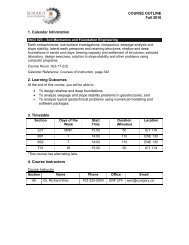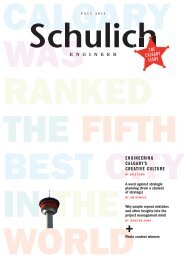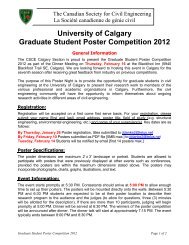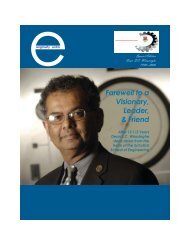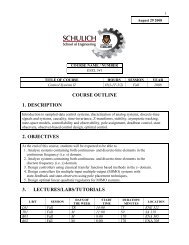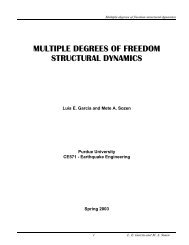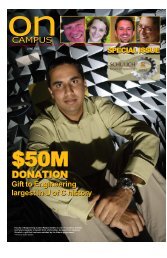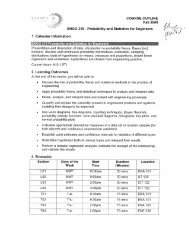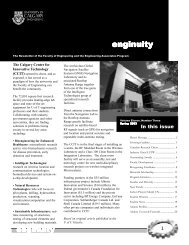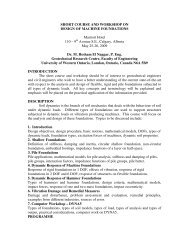Research Booklet - The Schulich School of Engineering - University ...
Research Booklet - The Schulich School of Engineering - University ...
Research Booklet - The Schulich School of Engineering - University ...
Create successful ePaper yourself
Turn your PDF publications into a flip-book with our unique Google optimized e-Paper software.
<strong>Research</strong> at the <strong>Schulich</strong> <strong>School</strong> <strong>of</strong> <strong>Engineering</strong>
<strong>The</strong> electrical and computer engineering department at the<br />
<strong>Schulich</strong> <strong>School</strong> <strong>of</strong> <strong>Engineering</strong> is highly regarded internationally<br />
for its leadership in biomedical engineering, radio systems,<br />
s<strong>of</strong>tware engineering, micro- and nano-scale systems, and<br />
power and energy research.<br />
With a focus on applications in health care, and energy and the<br />
environment, research is led by 42 full-time faculty members,<br />
including five chairholders, who work with 260 graduate students<br />
and a student body <strong>of</strong> 600 undergraduate students. Faculty<br />
members are leaders in multidisciplinary projects, education<br />
and research societies and organizations.
RESEARCH FACILITIES<br />
Biomedical <strong>Engineering</strong><br />
Biosystems <strong>Research</strong> and Application Group (BRAG)<br />
Biomedical Signal and Image Analysis Laboratory<br />
Biometric Systems <strong>Research</strong> Laboratory<br />
Biometric Technologies Laboratory<br />
CARP Biosystems Modeling Laboratory<br />
Low-Frequency Instrumentation Laboratory<br />
Information and Communication Technology: Radio Systems<br />
Intelligent RF Radio Technology Laboratory (iRadio Lab)<br />
Wireless/Optical Fiber Communications <strong>Research</strong> Laboratory<br />
Wireless Networking <strong>Research</strong> Laboratory<br />
Radio Frequency/ Microwave <strong>Research</strong> Laboratory<br />
RF Radio Technology Printed Circuits Laboratory<br />
Anechoic <strong>Research</strong> Laboratory<br />
Digital Signal Processing <strong>Research</strong> Laboratory<br />
Multimedia Signal Processing <strong>Research</strong> Laboratory<br />
Sensor Network <strong>Research</strong> Laboratory<br />
Embedded System <strong>Research</strong> Laboratory<br />
Information and Communication Technology: S<strong>of</strong>tware <strong>Engineering</strong><br />
S<strong>of</strong>tware Quality <strong>Engineering</strong> <strong>Research</strong> Laboratory<br />
<strong>The</strong>oretical and Empirical S<strong>of</strong>tware <strong>Engineering</strong> <strong>Research</strong> Centre<br />
Intelligent S<strong>of</strong>tware Systems <strong>Research</strong> Laboratory<br />
Visualization <strong>Research</strong> Laboratory<br />
Laboratory for S<strong>of</strong>tware <strong>Engineering</strong> Decision Support<br />
Human-Computer Interaction <strong>Research</strong> Laboratory<br />
Micro/Nano Systems<br />
Advanced Technology Information Processing Systems (ATIPS)<br />
Analog Electronics <strong>Research</strong> Laboratory<br />
Intelligent Sensors, Integrated Systems (ISIS) Laboratory<br />
Fully Integrated Systems and Hardware Laboratory<br />
Intelligent Video Systems <strong>Research</strong> Laboratory<br />
Advanced Micronanosystems Integration Facility (AMIF)<br />
Secure System-on-Chip (SOC) Laboratory<br />
Radio Frequency Integrated Circuits (RFIC) Laboratory<br />
Energy Systems<br />
Power <strong>Research</strong> Laboratory<br />
Power Electronics <strong>Research</strong> Laboratory<br />
Solid State Lighting and Human Development <strong>Research</strong> Laboratory<br />
Dynamics Power <strong>Research</strong> Laboratory<br />
Robotics <strong>Research</strong> Laboratory<br />
System Identification <strong>Research</strong> Laboratory
BIOMEDICAL ENGINEERING<br />
<strong>The</strong> results <strong>of</strong> the research performed in<br />
this department are assisting medical<br />
researchers, physicians, radiologists and<br />
surgeons. Collaborative research projects<br />
and partnerships with industries and<br />
medical specialists are aimed at<br />
significant advances in the effectiveness<br />
and delivery <strong>of</strong> health care.<br />
RESEARCH PROJECTS INCLUDE:<br />
• Development <strong>of</strong> “lab-on-a-chip” devices for<br />
testing, analyzing and diagnosing fluids on<br />
compact devices in a medical laboratory or<br />
at the point <strong>of</strong> care.<br />
• Development <strong>of</strong> intelligent and miniaturized<br />
instruments that may be swallowed or<br />
implanted to image, detect and treat<br />
abnormalities in the digestive system.<br />
• Wireless devices with information and<br />
communications technologies to monitor<br />
patients in hospitals.<br />
• Radio-frequency imaging devices and digital<br />
image processing techniques for the detection<br />
<strong>of</strong> breast cancer.<br />
• Computer models <strong>of</strong> the electrical activity <strong>of</strong><br />
the heart to understand cardiac disorders and<br />
improve the chance <strong>of</strong> success <strong>of</strong> defibrillation.<br />
• Novel devices and methods to measure<br />
and model the electrical activity <strong>of</strong> the<br />
gastrointestinal tract to understand and<br />
treat motility disorders, and to improve the<br />
utility <strong>of</strong> electrogastrography.<br />
• Digital signal processing techniques for<br />
noninvasive diagnosis <strong>of</strong> knee-joint pathology,<br />
to study motor control pathways, and for<br />
brain-computer interfaces.<br />
• Biometrics for surveillance and security.<br />
• Methods to compensate for susceptibility<br />
artifacts in magnetic resonance imaging.<br />
• Imaging systems and techniques to study stroke.<br />
• Design <strong>of</strong> microchips capable <strong>of</strong> detecting<br />
nuclear magnetic resonance in small samples<br />
<strong>of</strong> liquids or gases.<br />
• Techniques for detection, imaging, analysis,<br />
monitoring, repair, augmentation and<br />
replacement <strong>of</strong> bi<strong>of</strong>unctions.<br />
• Interfacing neurons to silicon chips.<br />
• Design <strong>of</strong> an implantable blood glucose monitor.<br />
• Methods for computer-aided diagnosis, surgery<br />
and therapy.
SOFTWARE ENGINEERING<br />
<strong>The</strong> primary research focus <strong>of</strong> the S<strong>of</strong>tware <strong>Engineering</strong> <strong>Research</strong><br />
Group (SERG) at the <strong>University</strong> <strong>of</strong> Calgary is on developing and<br />
evaluating methods, techniques and tools for the creation and<br />
maintenance <strong>of</strong> intelligent computing systems.<br />
<strong>The</strong> group has active collaborations with academic partners at<br />
local, national and international levels. <strong>Research</strong> projects also<br />
involve collaborations with organizations locally (such as the City<br />
<strong>of</strong> Calgary, Enbridge and Chartwells) and internationally (such as<br />
Google, IBM, Hewlett Packard, Siemens and Micros<strong>of</strong>t).<br />
RESEARCH PROJECTS INCLUDE:<br />
Innovative S<strong>of</strong>tware Products<br />
• Development and evaluation <strong>of</strong> industrial<br />
s<strong>of</strong>tware products using intelligent<br />
technologies (such as neuron-fuzzy nets,<br />
cognitive informatics, agent-based<br />
technologies, genetic algorithms, knowledge<br />
management and semantic integration).<br />
Requirements <strong>Engineering</strong><br />
• Techniques to capture, validate and gain a<br />
complete understanding and management<br />
<strong>of</strong> s<strong>of</strong>tware requirements, both initially, and<br />
at all subsequent stages <strong>of</strong> a system life<br />
cycle. We study the following areas from a<br />
practical viewpoint: managing the gaps<br />
between requirement engineering and<br />
s<strong>of</strong>tware design/architecture; elicitation,<br />
analysis, validation and management <strong>of</strong><br />
non-functional requirements.<br />
Testing and Quality <strong>Engineering</strong><br />
• Development and evaluation <strong>of</strong> methods,<br />
techniques and tools that help improve the<br />
quality <strong>of</strong> intelligent computing systems.<br />
“Quality” refers to product characteristics such<br />
as correctness, performance, availability,<br />
reliability, safety, usability, maintainability, etc.<br />
S<strong>of</strong>tware Process <strong>Engineering</strong><br />
• Methods, techniques and tools for the<br />
assessment, evaluation, and improvement <strong>of</strong><br />
s<strong>of</strong>tware development processes. This area<br />
includes the development and application <strong>of</strong><br />
intelligent decision-support systems and the<br />
application <strong>of</strong> s<strong>of</strong>tware process simulation.<br />
Empirical Evaluation <strong>of</strong> Products,<br />
Techniques and Processes<br />
• Development and application <strong>of</strong> empirical<br />
methods, techniques and tools for the<br />
evaluation <strong>of</strong> s<strong>of</strong>tware development products,<br />
techniques and processes in industrial<br />
environments.
RADIO SYSTEMS<br />
Information and communication<br />
technology (ICT) radio systems<br />
research in the department <strong>of</strong><br />
electrical and computer engineering<br />
in the <strong>Schulich</strong> <strong>School</strong> <strong>of</strong> <strong>Engineering</strong><br />
is advancing the core understanding<br />
and application <strong>of</strong> wireless radio<br />
and/or sensor networks that are<br />
embedded in the everyday<br />
environment, and which provide<br />
increased awareness, monitoring<br />
and control <strong>of</strong> our surroundings.<br />
<strong>The</strong> expertise and approach <strong>of</strong>ten<br />
lead to real hardware prototypes,<br />
helping to bridge the gap between<br />
fundamental research and<br />
commercialization, especially with<br />
a more “green” approach to radio<br />
systems. Within Calgary, there is<br />
a strong wireless industry to act as<br />
a receptor for graduating students<br />
and for research ideas.<br />
<strong>The</strong> department’s research and<br />
postgraduate training activities in<br />
ICT are organized into four groups<br />
working in cross-related areas.
RESEARCH AREAS:<br />
Applied Electromagnetics and Antenna<br />
Systems<br />
• Electromagnetic theory.<br />
• Fast and accelerated computational<br />
electromagnetic analysis and design<br />
techniques <strong>of</strong> 3D structures.<br />
• <strong>The</strong> design <strong>of</strong> phase array and smart antenna<br />
systems for wireless and satellite<br />
communications.<br />
• Advanced antenna systems for positioning<br />
and location applications.<br />
• Antennas and energy applicators for medical<br />
diagnostics, cancer detection and<br />
thermotherapy.<br />
• Antennas for automotive and ground radar<br />
penetrating applications.<br />
Communications, Networks and Sensors<br />
• Communications theory.<br />
• Combined/adaptive modulation and coding<br />
techniques.<br />
• Propagation measurements, channel<br />
modeling and blind equalization techniques.<br />
• Multiple-access and multi-user<br />
detection/estimation techniques.<br />
• Radio location, interference detection,<br />
cancellation and link quality estimation.<br />
Signal Processing and Applications<br />
• Fundamental research in estimation, detection,<br />
sampling and quantization theory, as well as<br />
multidimensional system theory.<br />
• Signal processing theory and the development<br />
<strong>of</strong> advanced and new algorithms and their<br />
implementation.<br />
• Adaptive signal processing techniques and their<br />
implementation.<br />
• 3D and multimode image processing, coding,<br />
compression, image enhancement and fusion.<br />
• Synthesis <strong>of</strong> high-level, real-time digital signal<br />
processors.<br />
Microwave <strong>Engineering</strong> and Radio Systems<br />
• Intelligent multimode, s<strong>of</strong>tware-defined and<br />
high-performance radio systems for emerging<br />
wireless and satellite communications operating<br />
up to millimetre-wave frequencies.<br />
• Advanced RF front-end design, agile transceiver<br />
design.<br />
• S<strong>of</strong>tware defined radio (SDR).<br />
• Power amplifiers.<br />
• Linearization, equalization and impairment<br />
compensation using digital signal processing<br />
techniques.<br />
• Embedded electronics.<br />
• Design <strong>of</strong> highly power efficient and very low<br />
energy consuming (“green”) electronics for future<br />
radio systems, as well as for multi-antenna and<br />
MIMO applications relevant to the modeling <strong>of</strong><br />
semiconductor devices.<br />
• Behaviour modeling <strong>of</strong> communication systems.<br />
• Development <strong>of</strong> new and advanced RF/microwave<br />
instrumentation and measurement techniques to<br />
support research.
MICRO/NANOTECHNOLOGY SYSTEMS<br />
<strong>The</strong> micro/nanotechnology research group has a well-established<br />
record in designing and building biomedical devices, sensor devices<br />
and networks, and micro/nano integration and packaging (known<br />
as convergence). <strong>Research</strong> is supported by a substantial fabrication<br />
facility, an established imaging lab, and a strong track record <strong>of</strong><br />
collaborative ties to other disciplines and organizations.<br />
EXPERTISE LIES IN:<br />
Nano-Magnetoelectronics (also known as<br />
Spintronics)<br />
• Materials in which electrons can be “flipped” in<br />
place to represent different logic values, rather<br />
than transporting them from one part <strong>of</strong> a<br />
semiconductor to another. This work has<br />
application to ultra-high-speed computers.<br />
Microelectro-Mechanical-Systems (MEMS)<br />
• Semiconductor technologies manipulated<br />
to perform mechanical functions as well as<br />
electronic, especially in the application <strong>of</strong><br />
MEMS to electromagnetic and biomedical<br />
applications. Successes include the design<br />
<strong>of</strong> electrostatic micro-motors, nuclear force<br />
microscopy, tunable electronic components<br />
and high-quality on-chip magnetic elements.<br />
Micr<strong>of</strong>luidics<br />
• Electronic control <strong>of</strong> liquid samples over<br />
specially engineered surfaces. This work<br />
allows for the analysis (flow cytometry) and<br />
manipulation <strong>of</strong> bio-materials for a number<br />
<strong>of</strong> chemical applications, most notably for<br />
medical purposes.<br />
Electronics<br />
• Advanced circuitry for communications and<br />
computing using nanoscale semiconductor<br />
transistor technology. Work includes amplifier<br />
design for the square-kilometer array telescope,<br />
high-speed wireless communications systems,<br />
and integrated circuits for filtering and control.<br />
Sensors<br />
• Optical sensors (cameras), building active pixel<br />
displays and realizing high dynamic range<br />
imagers using advanced silicon technologies.<br />
This work spans integrated circuit design and<br />
design <strong>of</strong> semiconductor photodetectors.<br />
“Green” Communications Systems<br />
• Advanced electronics using exotic<br />
semiconductor materials and design<br />
techniques for multi-antenna systems,<br />
very low energy (“green”) power circuits<br />
and millimeter wave communicators.<br />
Digital Systems<br />
• Automatic design <strong>of</strong> nano-scale digital<br />
computers including layout and verification<br />
<strong>of</strong> VLSI hardware as well as logic design<br />
techniques for Bayesian nanosystems.
POWER AND ENERGY RESEARCH<br />
Located in the heart <strong>of</strong> Canada’s energy powerhouse, the <strong>Schulich</strong><br />
<strong>School</strong> <strong>of</strong> <strong>Engineering</strong> plays a crucial role in supporting research in<br />
energy developments. <strong>The</strong> electrical power and energy group has<br />
wide-ranging expertise ranging. <strong>The</strong> group is also training future<br />
engineers to become the future leaders <strong>of</strong> the Canadian electrical<br />
energy section.
RESEARCH AREAS:<br />
Electric Energy Markets<br />
• Optimal operation, planning and management<br />
<strong>of</strong> deregulated electric energy markets.<br />
Adaptive Control and Artificial Intelligence<br />
Applications in Power System Control and<br />
Protection<br />
• Application <strong>of</strong> adaptive control, fuzzy logic and<br />
artificial neural networks in the control and<br />
protection <strong>of</strong> power systems.<br />
System Identification<br />
• Creation and validation <strong>of</strong> mathematical<br />
models <strong>of</strong> power system components, such as<br />
generators and loads, based on measurements<br />
<strong>of</strong> their inputs and outputs.<br />
Renewable Energy and Solid State Lighting<br />
• Renewable energy and solid state lighting,<br />
with applications in developing nations.<br />
This research is <strong>of</strong>ten done in cooperation<br />
with the Light Up the World foundation.<br />
Optimal Operation and Modeling <strong>of</strong> Power<br />
Systems with Stability Constraints<br />
• Tools that enhance the operation and modeling<br />
<strong>of</strong> electrical power systems, so that the<br />
probability <strong>of</strong> experiencing large-scale power<br />
failure events are minimized while maximizing<br />
the amount <strong>of</strong> load that can be serviced.<br />
Wind and Solar Power in Electrical Power<br />
Grids<br />
• Large integration <strong>of</strong> wind-powered generation<br />
in electrical grids.<br />
Power Converters for Wind and Solar<br />
Power<br />
• New ways to design power inverters for these<br />
renewable sources, including the use <strong>of</strong><br />
parallel inverter topologies, cascaded H-bridge<br />
inverters, and sparse matrix structures.<br />
Wind Power and Carbon Management<br />
• True carbon management benefits <strong>of</strong> wind<br />
power, the operating cost added to real power<br />
systems when significant amount <strong>of</strong> wind<br />
power is integrated, and the uncertainties<br />
<strong>of</strong> the above.<br />
Impacts on Electricity Market Prices<br />
• Analysis <strong>of</strong> delivered cost <strong>of</strong> electricity is<br />
dependent on technology type, fuel cost and<br />
access to transmission facilities. Realistic<br />
models <strong>of</strong> power systems with different levels<br />
<strong>of</strong> wind generation penetration are being<br />
developed and simulated.<br />
System Operation and Planning<br />
• Models are being developed, that integrate<br />
and compare existing policy with<br />
recommended changes that follow from<br />
this analysis, to advance and enhance<br />
transmission system planning tools.
Department <strong>of</strong> Electrical and<br />
Computer <strong>Engineering</strong><br />
<strong>Schulich</strong> <strong>School</strong> <strong>of</strong> <strong>Engineering</strong><br />
<strong>University</strong> <strong>of</strong> Calgary<br />
ICT 402, 2500 <strong>University</strong> Drive NW<br />
Calgary, Alberta T2N 1N4<br />
Tel: (403) 220-5806<br />
Fax: (403) 282-6855<br />
Email: ece.research@ucalgary.ca<br />
www.enel.ucalgary.ca



